Buddhism in Thailand
Contents
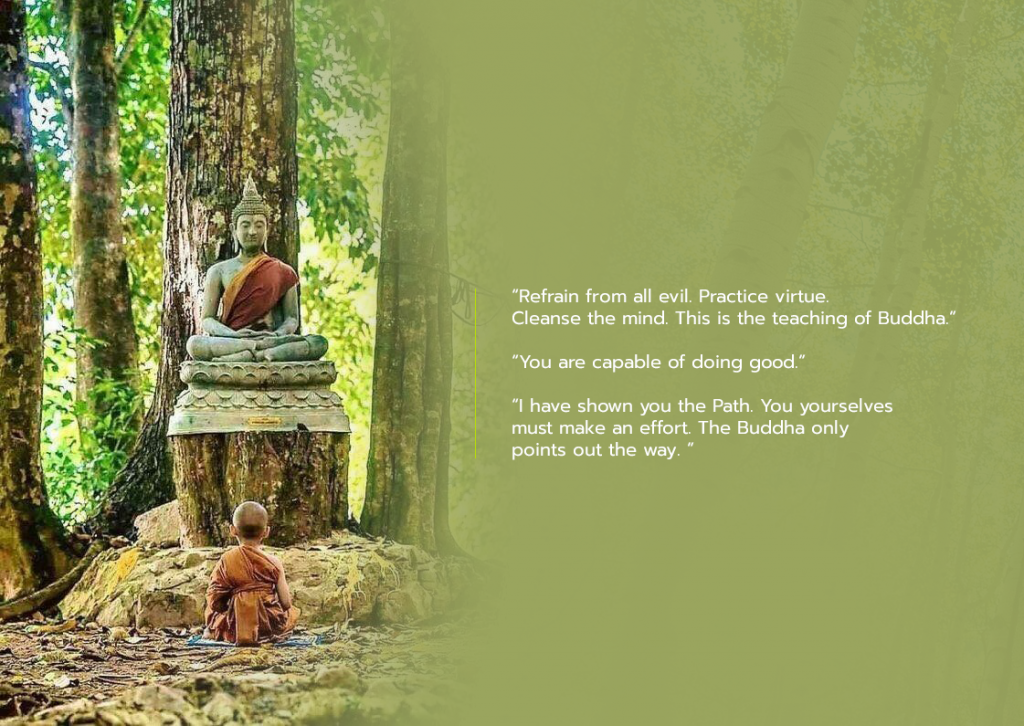
(Photo credit: https://bit.ly/2TIL1zV)
| Disclaimer: This is an article on Buddhism, a major global religion and system of beliefs with a complex history of more than 2,600 years. It is written to the best of the author’s knowledge. The intention of this article is to introduce Buddhism to readers, particularly in regards to its founder, history, doctrines, and usefulness through meditation. Many hyperlinks and reference video clips are suggested under each section in order to facilitate the readers’ further exploration of the Buddhist world and to allow them to reap the benefits of meditation. There is by no means an intention for this article alone to cover all subjects of Buddhism exhaustively. Note on the Pali terms used in the article: Originally, the Buddha’s Teachings were recorded in the Pali language. English translations of these terms sometimes vary. The author therefore finds it necessary to occasionally recall these original terms in parentheses, so that the readers may have reference to the original term where it may be useful. The author is extremely grateful to Phra Thepsakyawongpundit (Anilman Dhammasakiyo) for some comments. |
An Overview of Buddhism in Thailand
Buddhism is practically the state religion of Thailand (see hyperlink p. 14). Under the constitution, the king must be a Buddhist, even though he is the upholder of all five religions recognized by Thai law – Buddhism, Islam, Christianity, Brahmanism-Hinduism, and Sikhism. In 2019, there were 41,310 Buddhist temples with over 250,000 resident monks across Thailand.
According to the 2015 national census, out of the total Thai population of 67,228,562, 63,620,298 (94.50%) are Buddhists, 2,892,311 (4.29%) Muslims, 687,589 (1.17%) Christians, 22,110 Hindus (0.03), and 716 (0.001%) Sikhs. The rest are Confucian, believers of other religions, atheists, or agnostics.
In Thailand, Buddhism has influenced society for a long time. Many believe that has contributed to Thai people being generally known as kind, compassionate, tolerant, and accommodating. Daily life for most Thai people is inseparably connected with Buddhism from birth to death. For example, on having a newborn child, Thai Buddhist parents usually approach a respected monk to ask for an auspicious name. From their youngest days, people are also taught to pray and pay homage to “the Triple Gems” – the Buddha, dhamma, and the Sangha.
Read more : What is Buddhism?
Read more : The Meaning of Buddhism
Welcome to Bangkok, Thailand | DW Documentary
Although Thais practice both Theravada and Mahayana Buddhism, most are Theravada Buddhists. The Theravada lineage is then locally split into two sub-lineages: Maha Nikaya (Bigger Order) and Dhammayuttika Nikaya (Orthodox Order). The Mahayana lineage is also split into subsects. One subsect is a Chinese Mahayana called Chin Nikaya, which is practiced among Thai people of Chinese origin. The other is a Vietnamese Mahayana called Anam Nikaya, which is practiced among Thai people of Vietnamese origin.
Buddhism in Thailand
Origins of Theravada Buddhism in Thailand
In the first year of the Buddha’s teaching, the Buddha summoned 60 members of the Sangha (community) and said, “Bhikkhus, please listen. You are totally free, not bound by anything. You understand the Path of Liberation now. Proceed with confidence and you will make great strides. You can leave Isipatana [modern-day Sarnath, India] whenever you like. Walk as free persons and share the Way with others. Please sow the seeds of liberation and enlightenment to bring peace and joy to others. Teach the path of liberation, which is beautiful from beginning to end, in form and content. Countless others will benefit from your work of spreading Dhamma. As for me, I will leave soon. I plan to head east. I want to visit the Bodhi Tree. Afterwards I will go to visit a special friend in Rajagaha [modern-day Rajgir, Bihar).” Following these words, the missionaries would set off to various places in the Indian subcontinent and beyond.
The region that is present-day Thailand has had a relationship with Buddhism for more than two thousand years. In olden days, this region was known as Suvarnabhumi, meaning “Golden land.” One of the nine missions sent by King Asoka of India to spread Buddhism came to Suvarnabhumi. Present-day Nakorn Pathom was the capital of Suvarnabhumi and became an active center for the propagation of Buddhism. A great stupa has been erected there to memorialize the location’s importance.
Read more : Thai Buddhism in the Buddhist World, pp. 24-29

A photo of Phra Pathom Chedi at Nakorn Pathom in central Thailand. It was the first stupa in the Golden Peninsula and is the world’s tallest Buddhist monument (127 m.), with the origin traceable to King Asoka’s reign (3rd century B.C.E.). The term Phra Pathom Chedi means “the first pagoda built in Thailand”. (source: https://bit.ly/3bBVDqZ)

This map shows the spread of Buddhism to many parts of India as well as to many countries in Asia from 400 B.C. – 600 A.D. (source: https://bit.ly/3bBVDqZ).
Around 1057 A.D., when the people of Suvarnabhumi wielded political power in the Lanna Kingdom and in the Sukhothai Kingdom, Theravada Buddhism further spread. Rulers encouraged and supported Buddhism by building and maintaining monasteries, providing monks with material necessities and facilities, patronizing their education activities – such as the Buddhist Council, which revised the Tipitaka and translated it into Thai – and reforming the Sangha by appointing “Supreme Patriarchs” to govern the Sangha Order.

The Kingdom of Sukhothai (1238–1438 A.D.) is regarded by some scholars as the first united kingdom of the Thai people. All kings of Sukhothai were Buddhists and supporters of Theravada Buddhism.
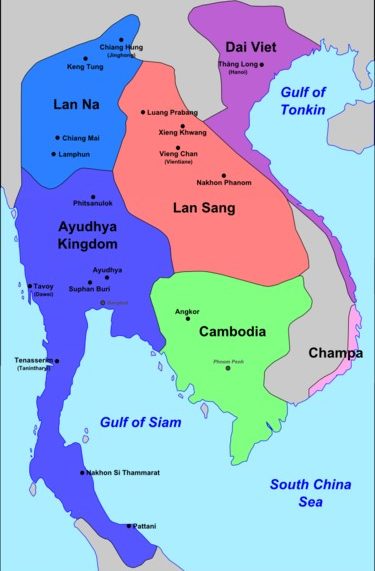
The Kingdom of Ayutthaya (1350–1767) succeeded the Kingdom of Sukhothai. All kings of this kingdom were also great patrons of Theravada Buddhism.
After the Ayutthaya Kingdom, Taksin the Great of the Thonburi Kingdom (1767-1782) became another great supporter of Thai Theravada Buddhism.
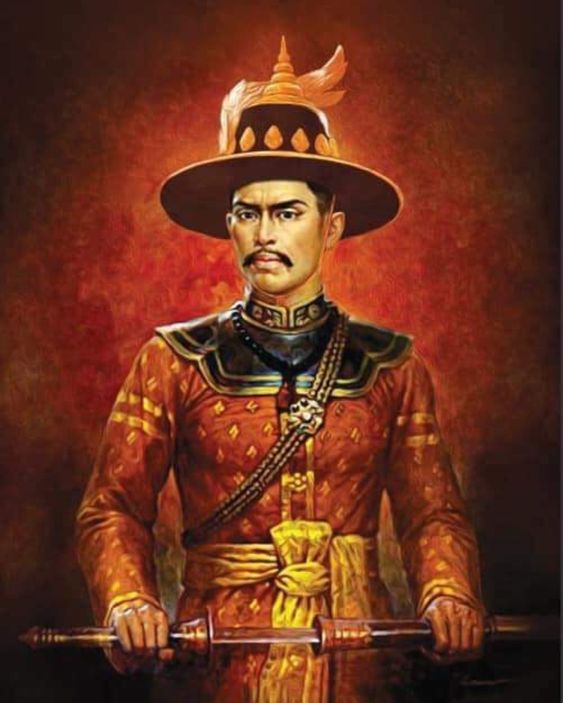
(Photo credit of Taksin the Great: https://bit.ly/2N5prmj)
All ten kings of the Chakri dynasty, the dynasty that has reigned over modern Thailand, have been Buddhists and patrons of Thai Theravada Buddhism. King Vajiralongkorn (Rama X) proclaimed during his coronation ceremony that he would protect Buddhism during his reign.
Read more : Thailand Crowns New King in Elaborate Buddhist and Brahmin Rituals
Read more : Coronation of the Thai monarch, 5.7 Defender of the Buddhist religion
Read more : Thai Buddhism in the Buddhist World, pp. 14-16
Becoming a Monk in Thailand for 24 Hours
How did Buddhism spread to Thailand?
Life of a Foreign Monk in Thailand (The Transformation into a Buddhist Monk)
Two Sub-Lineages of Thai Theravada Buddhism: Maha Nikaya and Dhammayuttika Nikaya
Maha Nikaya (Great Order) is one of the two principal monastic sub-lineages of modern Thai Buddhism. The other is Dhammayuttika Nikaya (Orthodox Order), which began in 1833 as a reform movement led by Prince Mongkut, son of King Rama II. The Maha Nikaya is larger in terms of monk population, making up over 90% of the Buddhist monks in the country.
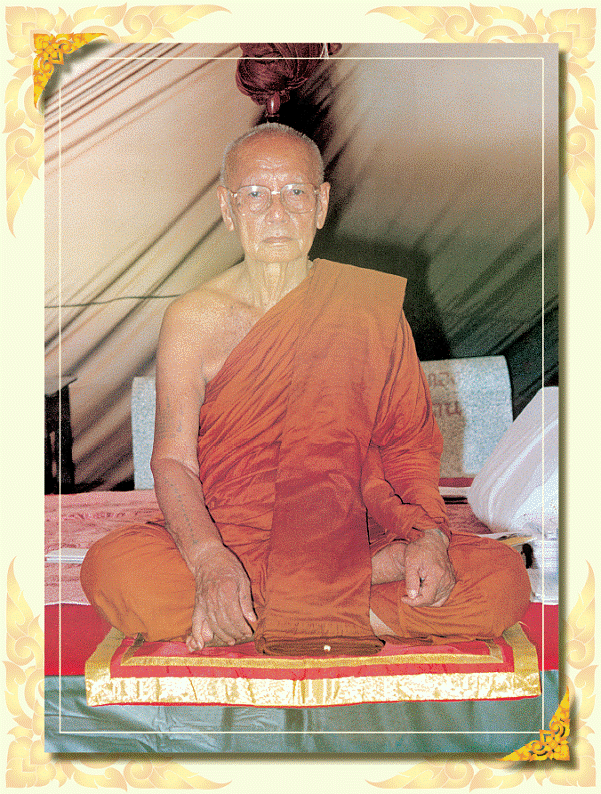
(Picture of a senior monk in Mahanikaya branch, credit: https://bit.ly/3g0ARlR)
Dhammayuttika Nikaya was born after Prince Mongkut entered monastic life in 1824 at the age of 20, when he saw discrepancies between the practices of Thai monks and the rules given in the Pali Canon – differences that he thought needed to be rectified. In 1836, Mongkut became the first abbot of Wat Bowonniwet Vihara and reformed Thai Buddhism to become more orthodox. His efforts during his twenty-seven years of monkhood included the removal of all non-Buddhist folk religions and superstitious elements, which had become core parts of Thai Buddhism by the time. Dhammayuttika Nikaya remained a reform movement until 1902, with the passage of the Sangha Act, which formally recognized it as one of the Thai Theravada subsects.
Read more: Buddhism in Thailand’s topic on Two Sects or Nikayas at https://bit.ly/3epP6By
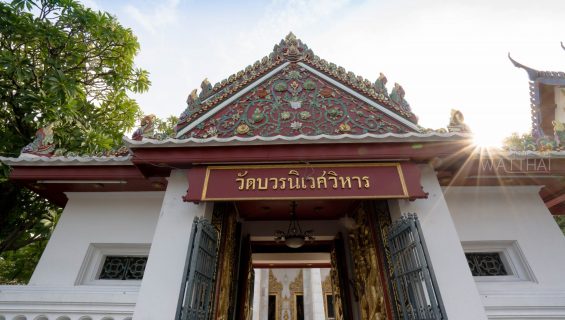
(Picture of Bowonniwet Vihara Temple, photo credit: https://bit.ly/3wJMKn1)
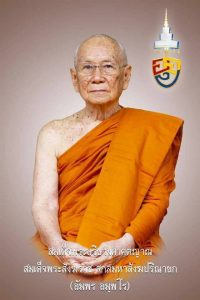
Overlooking the two subsects is The Supreme Patriarch of Thailand.
(In the picture: the present Supreme Patriarch of Thailand, who is also from Dhammayuttika Nikaya, credit: https://bit.ly/3i4srMZ)
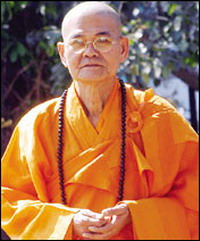
Leader of Chin Nikaya Mahayana Sect of Thailand.
(photo credit: คณะสงฆ์จีนนิกายแห่งประเทศไทย – วิกิพีเดีย (wikipedia.org)
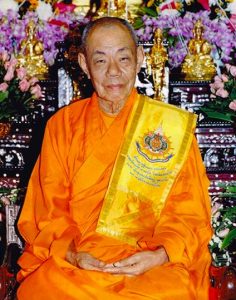
Leader of Anam Nikaya Mahayana Sect of Thailand.
(photo credit: https://www.anamnikayathai.com/)
Roots of secular Buddhism
Influences of Theravada Buddhism in Present-Day Thailand
Buddhism has influenced many aspects of Thai life and culture. Thai lifestyles, traditions, mannerisms, arts, architecture, and language are among the myriad of aspects influenced by Buddhism. Buddhism has inspired Thai literature and many Thai art forms, especially mural paintings, which cover the interior walls of most temples. On the linguistic level, Pali and Sanskrit, which are used in Buddhist chants and are necessary components to study Buddhism, are recognized in Thailand as classical languages. A large number of Thai words, especially those used in language towards royalty and written language are derived from Pali and Sanskrit. Furthermore, senior members of the Sangha bless in Pali most state and public ceremonies, as well as household and family ceremonies, such as housewarmings, birthday celebrations, weddings, funeral rites, and memorial services. In the home, many Thais keep images of the Buddha of various sizes on small altar-tables, for home-based worship as shown in the picture below.
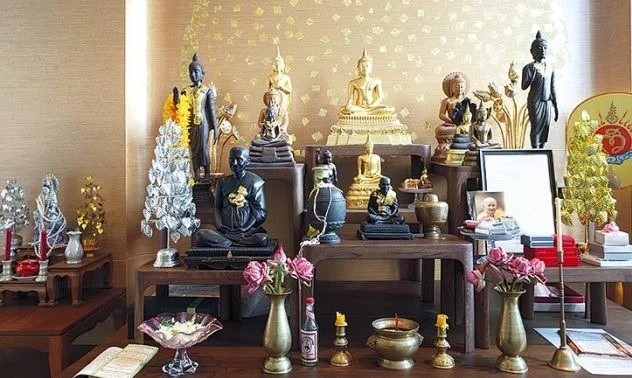
(credit: https://bit.ly/3vHIdkH)
When travelling, many Thai people also wear a chain of small Buddha images around their necks and/or place a small Buddha statue or a highly respected monks’ image (as shown in the two pictures on the left taken by the author) in their cars as objects of veneration and recollection, or as amulets for adornment and protection. When passing sacred places such as the Royal Chapel of the Emerald Buddha (Wat Phrakaeo, on the left, credit: https://bit.ly/3c95lkv) in Bangkok, devout Buddhists never fail to pay respect with a wai – a unique gesture of paying respect – at the very least. And certainly, multiple times a year, festivals are held at temples and monasteries.
Read more : Arrangement of Buddha’s statues in a house (in Thai).

(as shown in the two pictures on the left taken by the author)
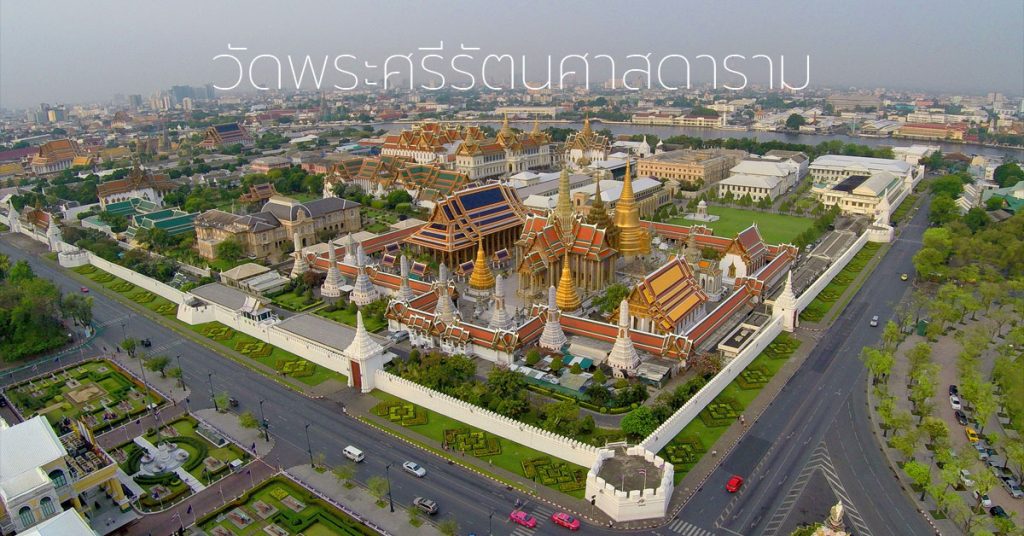
(Wat Phrakaeo credit: https://bit.ly/3c95lkv)
The Experiment in Thailand: Buddhist Traditions & Thai Culture
Thai Buddhist Culture (The Middle Way Meditation Institute)
Buddhist culture: Philosophy pivotal to Thailand’s resilience
There are a few public holidays in accordance with important days for Buddhists. At present, four Buddhist holy days are recognized by the government as national holidays, namely:
1. Magha Puja Day: a day that commemorates the spontaneous gathering of 1,250 monks who had come to pay respect to the Buddha, who then gave his important sermon that taught “performing no evil,” “doing what is good,” and “purifying one’s mind (Pali: citta).”
Read More : Magapuja Day
Read More : How to Celebrate Magha Puja Day in Thailand
Read More : Finding peace in northern Thailand
Magha Puja – Holidays Around the World (Buddhism)
2. Visakha Puja Day: a day to commemorate the birth, the enlightenment, and the death of the Buddha.
Read More : The Relevance of Visaka Bucha Day to Thailand People
Read More : Vishakha Puja Day (Visak)
Vesak Day | Short Documentary
Euronews Life – Thailand’s spiritual soul
3. Asalha Puja Day: a day to commemorate the discovery of the Path to Enlightenment in the Buddha’s first sermon.
Read More : ASALHA PUJA DAY
Read More : Happy Asalha Puja Day!
Faith Time: Festival of Asalha Puja
4. Khao Pansa Day: the first day of the annual Buddhist Lent.
Read More : Khao Phansa festivals across Thailand
Thailand: Colourful river festival marks the beginning of Buddhist Lent
History of Buddhist Rains Retreat
Occasionally, Thai Buddhists may also go on a pilgrimage to their most preferred shrines, sometimes located in remote places. Monastery buildings, such as the Uposatha Hall which serves as the main repository of Buddha images, are usually the most beautiful and ornate buildings in countryside villages. The Uposatha Hall is where ordination ceremonies are typically held, and are thus an important site for male Buddhists, who observe a tradition of becoming a monk for a certain period of time upon reaching adulthood.
Read more : Why do Buddhist Men Become Monks Before Marriage?
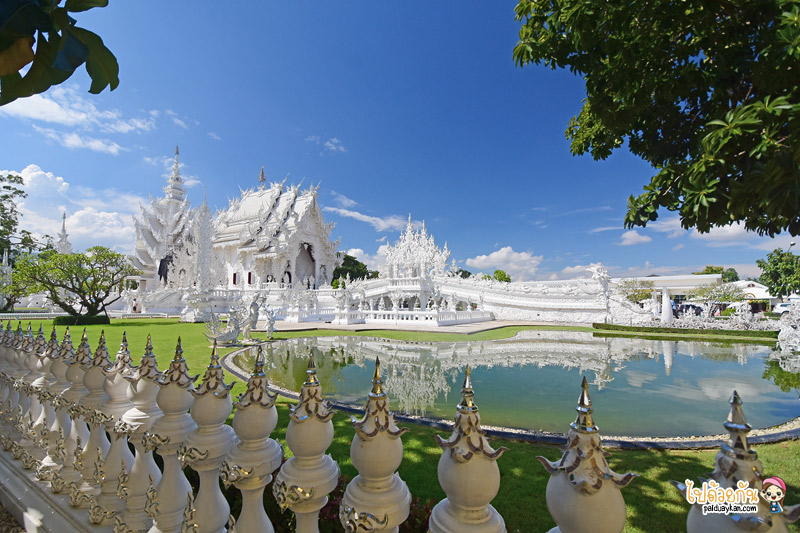
(Uposatha Hall of Rongkhun Temple in Chiang Rai Province, in northern Thailand, photo credit: https://bit.ly/3wrIWXu)
Monk & Novice Ordination Ceremony in the Northeastern of Thailand | Tradition | Documentary
However, what is most important to us in this article is to know that meditation, especially Mindfulness Meditation, has a paramount role in the Thai life. It is the tool that the Buddha used to achieve enlightenment, and many Thais nowadays use the method to improve their own mental and physical health.
AUTHOR
Paitoon Songkaeo, PhD


